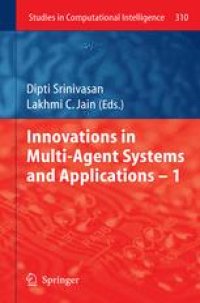
Ebook: Innovations in Multi-Agent Systems and Applications - 1
- Tags: Appl.Mathematics/Computational Methods of Engineering, Artificial Intelligence (incl. Robotics)
- Series: Studies in Computational Intelligence 310
- Year: 2010
- Publisher: Springer-Verlag Berlin Heidelberg
- Edition: 1
- Language: English
- pdf
This book provides an overview of multi-agent systems and several applications that have been developed for real-world problems. Multi-agent systems is an area of distributed artificial intelligence that emphasizes the joint behaviors of agents with some degree of autonomy and the complexities arising from their interactions. Multi-agent systems allow the subproblems of a constraint satisfaction problem to be subcontracted to different problem solving agents with their own interest and goals. This increases the speed, creates parallelism and reduces the risk of system collapse on a single point of failure. Different multi-agent architectures, that are tailor-made for a specific application are possible. They are able to synergistically combine the various computational intelligent techniques for attaining a superior performance. This gives an opportunity for bringing the advantages of various techniques into a single framework. It also provides the freedom to model the behavior of the system to be as competitive or coordinating, each having its own advantages and disadvantages.
This book provides an overview of multi-agent systems and several applications that have been developed for real-world problems. Multi-agent systems is an area of distributed artificial intelligence that emphasizes the joint behaviors of agents with some degree of autonomy and the complexities arising from their interactions. Multi-agent systems allow the subproblems of a constraint satisfaction problem to be subcontracted to different problem solving agents with their own interest and goals. This increases the speed, creates parallelism and reduces the risk of system collapse on a single point of failure. Different multi-agent architectures, that are tailor-made for a specific application are possible. They are able to synergistically combine the various computational intelligent techniques for attaining a superior performance. This gives an opportunity for bringing the advantages of various techniques into a single framework. It also provides the freedom to model the behavior of the system to be as competitive or coordinating, each having its own advantages and disadvantages.
This book provides an overview of multi-agent systems and several applications that have been developed for real-world problems. Multi-agent systems is an area of distributed artificial intelligence that emphasizes the joint behaviors of agents with some degree of autonomy and the complexities arising from their interactions. Multi-agent systems allow the subproblems of a constraint satisfaction problem to be subcontracted to different problem solving agents with their own interest and goals. This increases the speed, creates parallelism and reduces the risk of system collapse on a single point of failure. Different multi-agent architectures, that are tailor-made for a specific application are possible. They are able to synergistically combine the various computational intelligent techniques for attaining a superior performance. This gives an opportunity for bringing the advantages of various techniques into a single framework. It also provides the freedom to model the behavior of the system to be as competitive or coordinating, each having its own advantages and disadvantages.
Content:
Front Matter....Pages -
An Introduction to Multi-Agent Systems....Pages 1-27
Hybrid Multi-Agent Systems....Pages 29-42
A Framework for Coordinated Control of Multi-Agent Systems....Pages 43-67
A Use of Multi-Agent Intelligent Simulator to Measure the Dynamics of US Wholesale Power Trade: A Case Study of the California Electricity Crisis....Pages 69-111
Argument Mining from RADB and Its Usage in Arguing Agents and Intelligent Tutoring System....Pages 113-147
Grouping and Anti-predator Behaviors for Multi-agent Systems Based on Reinforcement Learning Scheme....Pages 149-182
Multi-agent Reinforcement Learning: An Overview....Pages 183-221
Multi-Agent Technology for Fault Tolerant and Flexible Control....Pages 223-246
Timing Agent Interactions for Efficient Agent-Based Simulation of Socio-Technical Systems....Pages 247-276
Group-Oriented Service Provisioning in Next-Generation Network....Pages 277-298
Back Matter....Pages -
This book provides an overview of multi-agent systems and several applications that have been developed for real-world problems. Multi-agent systems is an area of distributed artificial intelligence that emphasizes the joint behaviors of agents with some degree of autonomy and the complexities arising from their interactions. Multi-agent systems allow the subproblems of a constraint satisfaction problem to be subcontracted to different problem solving agents with their own interest and goals. This increases the speed, creates parallelism and reduces the risk of system collapse on a single point of failure. Different multi-agent architectures, that are tailor-made for a specific application are possible. They are able to synergistically combine the various computational intelligent techniques for attaining a superior performance. This gives an opportunity for bringing the advantages of various techniques into a single framework. It also provides the freedom to model the behavior of the system to be as competitive or coordinating, each having its own advantages and disadvantages.
Content:
Front Matter....Pages -
An Introduction to Multi-Agent Systems....Pages 1-27
Hybrid Multi-Agent Systems....Pages 29-42
A Framework for Coordinated Control of Multi-Agent Systems....Pages 43-67
A Use of Multi-Agent Intelligent Simulator to Measure the Dynamics of US Wholesale Power Trade: A Case Study of the California Electricity Crisis....Pages 69-111
Argument Mining from RADB and Its Usage in Arguing Agents and Intelligent Tutoring System....Pages 113-147
Grouping and Anti-predator Behaviors for Multi-agent Systems Based on Reinforcement Learning Scheme....Pages 149-182
Multi-agent Reinforcement Learning: An Overview....Pages 183-221
Multi-Agent Technology for Fault Tolerant and Flexible Control....Pages 223-246
Timing Agent Interactions for Efficient Agent-Based Simulation of Socio-Technical Systems....Pages 247-276
Group-Oriented Service Provisioning in Next-Generation Network....Pages 277-298
Back Matter....Pages -
....